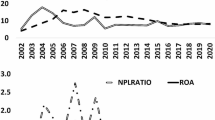Abstract
The survival pattern of Swedish commercial banks during the period 1830--1990 is studied by parametric and non-parametric event-history methods. In particular we study the sensitivity of the conclusions reached with respect to the model used. It is found that the hazard is inversely U-shaped, which means that models that cannot allow for this type of hazard run into difficulties. Thus two of the most popular approaches in the analysis of event history data, the Gompertz and the Weibull models produce misleading results regarding the development of the death risk of banks over time. As regards the effect of explanatory variables on survival, on the other hand, most models are found to be robust and even in cases of misspecified baseline hazards, the estimated effects of the explanatory variables do not seem to be seriously wrong.
Similar content being viewed by others
References
Addison, J.T. and Portugal, P. (1987). On the distributional shape of unemployment duration, Review of Economics and Statistics 69: 520–526.
Bergström, R., Engwall, L., & Wallerstedt, E. (1991). Organizational foundations and closures in a regulated environment: Swedish Commercial Banks 1831–1990. Working Paper 1991/4, Department of Business Studies, Uppsala University, Uppsala.
Bergstrom, R., Engwall, L., & Wallerstedt, E. (1994). Organizational foundations and closures in a regulated environment: Swedish Commercial Banks 1831–1990, Scandinavian Journal of Management 10: 29–48.
Bergström, R. & Edin, P.-A. (1992). Time aggregation and the distributional shape of unemployment duration, Journal of Applied Econometrics 7: 5–30.
Blossfeld, H.P. & Hamerle, A. (1992). Unobserved heterogeneity in event history models. Quality and Quantity 26: 157–168.
Breslow, N.E. (1986). Logistie regression, proportional hazards and related methods for the analysis of chronic disease risk. German-American Seminar on Longitudinal Studies and Their Analyses, Institute for Social Medicine and Epidemiology of the Federal Health Office, Berlin, June 1986.
Kalbfleisch, J.D. & Prentice, R.L. (1980). The Statistical Analysis of Failure Time Data, Wiley, New York.
Kiefer, N.M. (1988). Economic duration data and hazard functions, Journal of Economic Literature 26: 646–679.
Lawless, J.F. (1982). Statistical Models and Methods for Lifetime Data, Wiley, New York.
Narendranathan, W. and Stewart, M. (1990). An examination of the robustness of models of the probability of finding a job for the unemployed, in Hartog, J., Ridder, G., & Theeuwes, J. (eds.), Funel Data and Labor Market Studies, North Holland: Amsterdam, 135–156.
Prentice, R.L. (1974). A log-gamma model and its maximum likelihood estimation, Biometrika 61: 539–544.
Singh, J.V., House, R.J., & Tucker, J.D. (1986). Organizational change and organizational mortality, Administrative Science Quarterly 31: 587–611.
Stacy, E.W. (1962). A generalization of the gamma distribution, Annales of Mathematical Statistics 33: 1187–1192.
Thompson, W.A., Jr. (1977). On the treatment of grouped observations in life statistics, Biometrika 33: 463–470
Tucker, D., Singh, J.V., & Meinhard (1990). Organizational form, population dynamics, and institutional change: the founding patterns of voluntary organizations, Academy of Management Journal 33: 151–178.
Author information
Authors and Affiliations
Rights and permissions
About this article
Cite this article
Bergstro¨m, R., Engvall, L. & Wallerstedt, E. The importance of flexible hazard functions in the analysis of organizational survival data -- experiences from a cohort of Swedish commercial banks. Quality & Quantity 31, 15–35 (1997). https://doi.org/10.1023/A:1004290505710
Issue Date:
DOI: https://doi.org/10.1023/A:1004290505710




